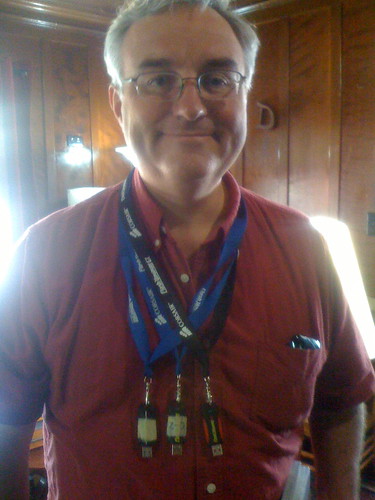The most obvious transition in technology that you see evident in this UGM, is the growth in the importance of GPU hardware. Early UGMs had one GPU, then you would find two gpus, and now with this UGM, three GPUs. I would say that the single most important components for the UGMs mind bending processing power, is its set of triple water cooled BFG GTX 280 graphics cards working in SLI. In the past GPUs were only only used for applications like video games and 3d CAD programs, but now as operating system GUIs require more graphics power, and as companies like NVIDIA allow devlopers to take advantage of the processing power of their chips for new uses with technologies like CUDA, I think we are seeing the GPU rise in importance to the level of the CPU, and maybe then suprassing it.

You can see in Apple's most recent Macbook revisions, where they replaced the nasty integrated graphics on their models with nicer NVIDIA silicon. This is evidence that GPU computing is going mainstream, and that machines are not designed for gamers must have discrete graphics hardware. Now as applications for tasks as common
a
s photo editing are able to use GPU acceleration, the general consumer... and in turn the people who design computers for them... can benefi
t from having a discrete graphics chip in their machine instead of integrated graphics. For pro users, this will make a large impact on the time that is spent processing and rendering. We could, for example, use a GPGPU program called Badaboom, from Elemental, to transcode three movies simultaneously from mpg to h.264.... at ultra high speed... simultaneously with the UGM.

Also evident in the UGM design, was our search for extremely fast data storage and retreival. We chose to stick two 10,000 rpm Western Digital VelociRaptor hard drives in the machine, and then link them in a RAID 0 array to combine their speeds. If we were to make the product selection at the time of its completion, rather than at the beginning, we would probably use the new Intel SSD drives that are available which provide comperable speed with only one device and no raid array. However, SSDs at this point still make some people uncomfortable about their potential longevity, though that is fading. Because of our discomfort in the fact that SSDs are untested over large periods of time, and that RAID 0 essentially doubles the possibility of loosing all of your data, we decided to pair a Drobo storage device with the UGM to make sure that essential data can be absolutely safe. If we were building a whole network to go with this UGM, we would have probably used a network attached storage device.

You may be noticing a pattern of multiple parts doing the same job at the same time. We are using two processors in RAID 0, we are using a chip with four cores, and we are using three graphics cards. I see this pattern of linking multiple parts together for high performance computing continuing on into the future. Even a new OCZ SSD drive that Ryan Shrout from PC Perspective recently reviewed has an internal RAID 0 setup from the factory to increase speed. I think its evident that parallel processing is here to stay, and even your grandmother one day soon will have octo-core hybrid-sli laptops!
Go granny go... goooo grannny go go go.
The biggest hold back in the progression of stream and multiprocessor computing, is the fact that software creators are still learning to to unleash the power that this hardware can offer. Programs have been in the past designed for single threaded CPUs, but with four or eight threads, three GPUs, and more to come, how are we going to break up the workload and spread it across the various parts? There are ambitious projects, like OpenCL, that aim to create an API to do just this effectively. This is going to be big.
- Colleen
 Admin
Admin  July 2, 2009
July 2, 2009 
 Geek,
Geek,  USB,
USB,  leo laporte
leo laporte 


 Also evident in the UGM design, was our search for extremely fast data storage and retreival. We chose to stick two 10,000 rpm Western Digital VelociRaptor hard drives in the machine, and then link them in a RAID 0 array to combine their speeds. If we were to make the product selection at the time of its completion, rather than at the beginning, we would probably use the new Intel SSD drives that are available which provide comperable speed with only one device and no raid array. However, SSDs at this point still make some people uncomfortable about their potential longevity, though that is fading. Because of our discomfort in the fact that SSDs are untested over large periods of time, and that RAID 0 essentially doubles the possibility of loosing all of your data, we decided to pair a Drobo storage device with the UGM to make sure that essential data can be absolutely safe. If we were building a whole network to go with this UGM, we would have probably used a network attached storage device.
Also evident in the UGM design, was our search for extremely fast data storage and retreival. We chose to stick two 10,000 rpm Western Digital VelociRaptor hard drives in the machine, and then link them in a RAID 0 array to combine their speeds. If we were to make the product selection at the time of its completion, rather than at the beginning, we would probably use the new Intel SSD drives that are available which provide comperable speed with only one device and no raid array. However, SSDs at this point still make some people uncomfortable about their potential longevity, though that is fading. Because of our discomfort in the fact that SSDs are untested over large periods of time, and that RAID 0 essentially doubles the possibility of loosing all of your data, we decided to pair a Drobo storage device with the UGM to make sure that essential data can be absolutely safe. If we were building a whole network to go with this UGM, we would have probably used a network attached storage device.


